The few oldest civilisations in the world had all developed some form of astrology from the study of astronomy, as our ancestors realised that planetary movements do influence the destiny of human kind. The original Chinese astrology methodologies, however, did not flourish well like their western counterparts, because Chinese rulers from as early as the Chunqiu period (777-476 B.C.) had forbade their wide spread practice for fear of uprisings.
The only form of Chinese astrology that managed to grow was Wuxing (the Five Stars Method) but it was not refined at all when compared to Western astrology methodologies (including Verdic, of course) that have developed uninterrupted.
Wuxing first uses Ganzhi (Stem/Branch) to build four pillars from year, month, day and hour of birth, then studies the positions of Mercury, Venus, Mars, Jupiter and Saturn, together with the sun and the moon, in four sectors, to read the four pillars. Hence, Wuxing is also called Qizheng Siyu (Seven Stars and Four Sectors).
The Ziping Method (Bazi Method, or the Four Pillars Method) was refined from the first part of Wuxing, using the four pillars of birth, but ignoring totally the reliance of planetary movements. Although the Ziping Method finally gained ground over Wuxing after further refinements during the Tang Dynasty by Master Li Xuzhong, and later, Master Xu Ziping, it is not able to provide certain specifics in reading like Wuxing because of its different approach. It was said that a new methodology was created at that time, that was able to provide more details in reading, to compete with Ziping in place of Wuxing. This new method was call the Eighteen Flying Stars (Shiba Feixing) and it is the first time the phrase Ziwei appeared in a destiny analysis methodology.
While some like to take Shiba Feixing as a form of Ziwei Doushu, which, in fact, was created later, they are not the same. Ziwei Doushu appeared in the Song Dynasty and it is much more dynamic and detailed than Shiba Feixing. As the name implies, again, Shiba Feixing uses only 18 stars in addition to Ziwei, while Ziwei Doushu employs 120 stars in addition to Ziwei, and the former does not provide reading in periodic luck, while Ziwei Doushu goes all the way from 10-year cycles to annual cycles, monthly cycles, daily cycles and hourly cycles.
It remains a mystery who had invented Ziwei Doushu, although it is generally created to a Taoist priest Chen Xiyi in Song Dynasty. However, official historical records and unofficial notes from the Song Dynasty have never associated Chen Xiyi with Chinese metaphysics.
Although Ziwei Doushu has achieved the goal of providing strong competition to Ziping because it is in the capacity to give enormous specific details, the methodology did not flourish for the next 1,000 years for two reasons. First, while able to provide detailed readings, the method did not provide the logic of the interpretations, and it was seemingly not based on profound theoretical basis like Ziping. Second, it has become the exclusive instrument of the Bureau of Astronomy of the Ming and Qing Dynasties, used to serve only the Emperor. Therefore, Ziping was the only well known main stream destiny analysis method until the recent times, when some masters began teaching Ziwei Doushu openly after World War II.
Slide 1
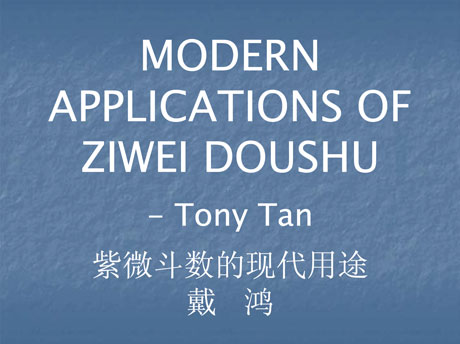
Commentary - Ziwei Doushu first appeared in the Song Dynasty, hence, it has a history of slightly more than 1,000 years.
Slide 2
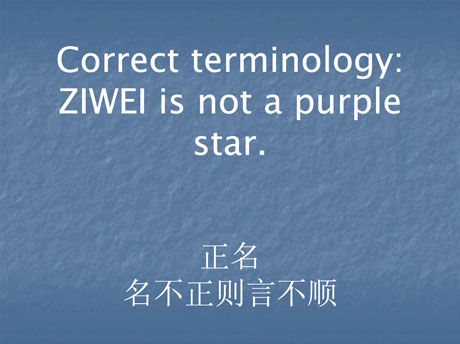
Commentary - There is nothing *purple* in Ziwei Doushu. It is wrong to call Ziwei the purple star, thus, it is wrong to call Ziwei Doushu the Purple Star Astrology. For instance, there is nothing purple in Zijincheng - the Forbidden City (the Purple City?), and there is nothing purple in Ziqi Donglai - auspiciousness (purple energy from the East?). It is like we cannot translate white elephant from English to Chinese directly - there is nothing white, and it is not even an elephant.
Slide 3 & 4
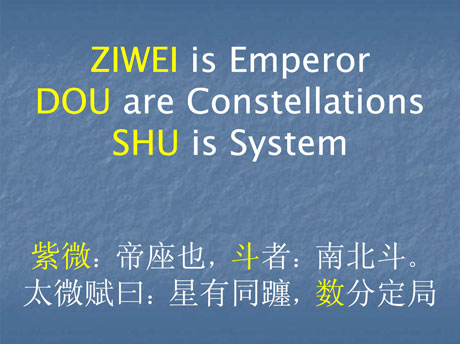
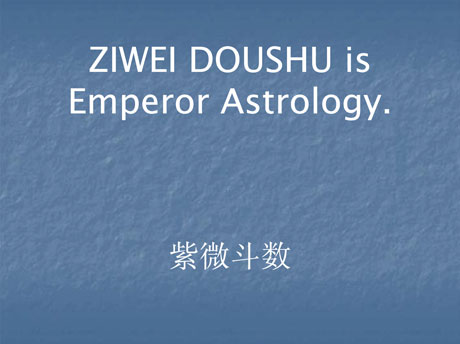
Commentary - Ziwei refers to the centre of focus, the reference, the authority, etc., thus it is apt to translate it as the Emperor. Dou refers to the stars (symbols) when they are static, i.e., their essential quality. Shu refers to the systems the stars form when they move, and there are 120 systems. Shu therefore refers to the dynamism the stars create. However, it is critical to note that there are no real stars in Ziwei Doushu. The term *stars* is the accepted way to mean the *symbols* we use in Ziwei Doushu. Thus, Ziwei Doushu is Emperor Astrology.
Slide 5 & 6
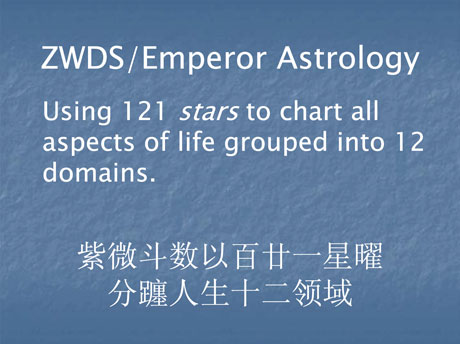
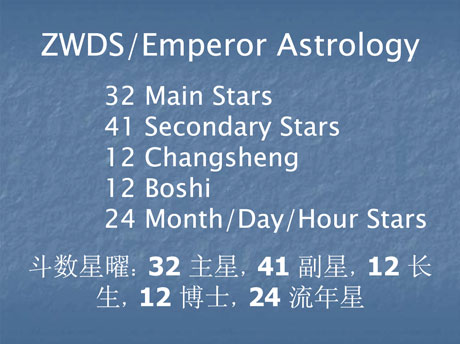
Commentary - There are a total of 121 *stars* used in ZWDS, but this figure depends on how we count them. For instance, the 12 Boshi Stars are employed twice, some may count them as 24 stars, etc.
Slide 7
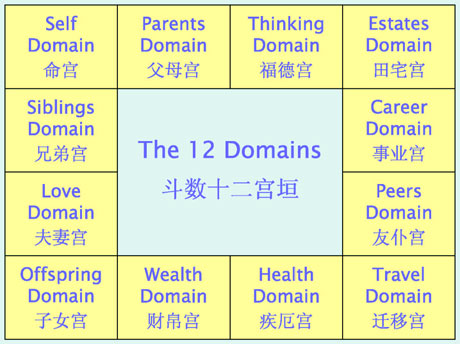
Commentary - These are the twelve domains of life that ZWDS interprets. I have chosen the word DOMAIN in place of PALACE or COURT because unlike face reading and Fengshui, the Chinese word gong here does not refer to a location or position. The Self Domain may be placed in any of the twelve frames, but the sequence of the twelve does not change. ZWDS is about reading the meaning of the stars when they are placed in the twelve domains.
Slide 8
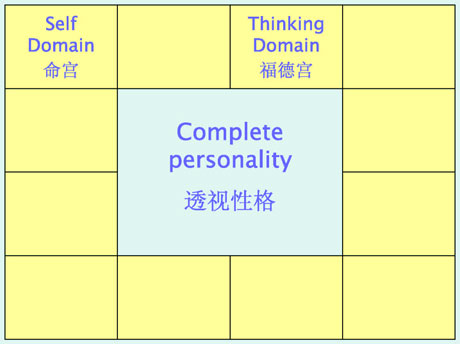
Commentary - These are the two domains we should interpret together to understand a personality completely. Thinking Domain is the most misunderstood of all the twelve because of the original Chinese words Fudegong, when fu generally means blessing and de generally means virtue or karma, but they do not mean those when it comes to Fudegong. We should call a spade a spade. Self Domain shows the outwardly apparent personality and the Thinking Domain reveals that part that is hidden.
Slide 9
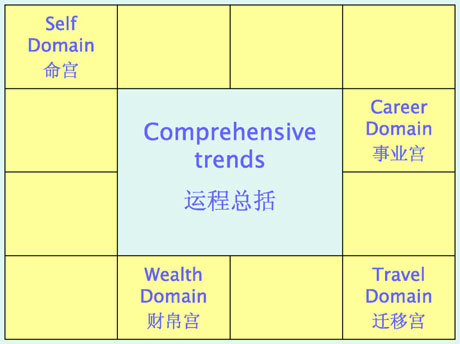
Commentary - These four domains form Sanfang Sizheng - what I call the Matrix. They reveal the aggregate strength (luck) of destiny we have in this life.
Slide 10
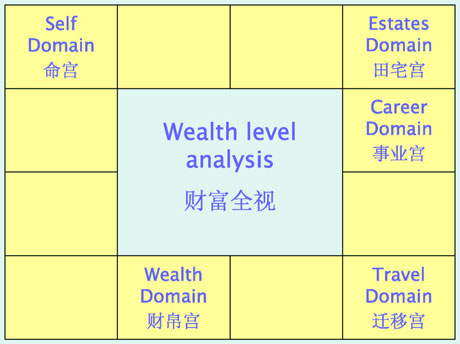
Commentary - To assess how wealthy one can be, we have to also include the interpretation of Estates Domain as it represents wealth beyond liquid cash.
Slide 11/12/13
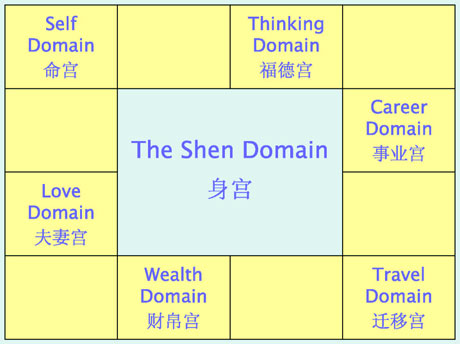
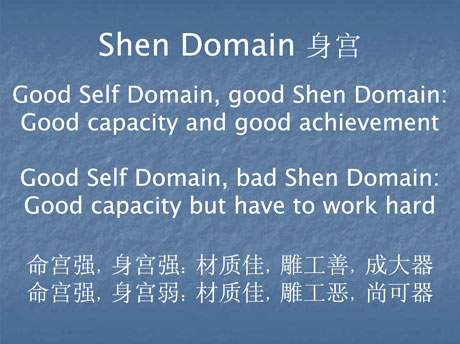
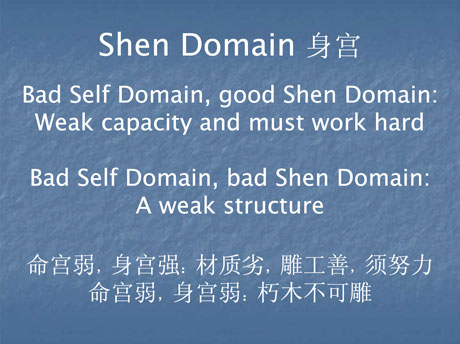
Commentary - Beyond the twelve domains, there is a Shengong - what I call a supplementary domain, or the domain of main influence, but it is formed by one of the six domains shown in Slide 11.
Slide 14
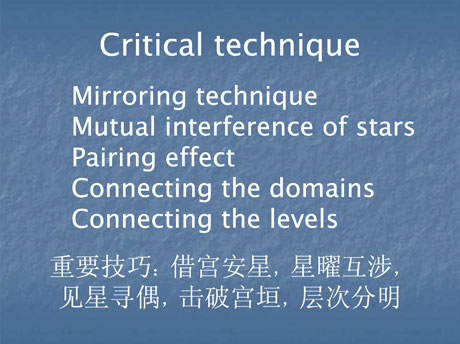
Commentary - This shows the key interpretation technique of ZWDS. One will never understand the true power of ZWDS if one does not get familiarised with their applications.
Slide 15
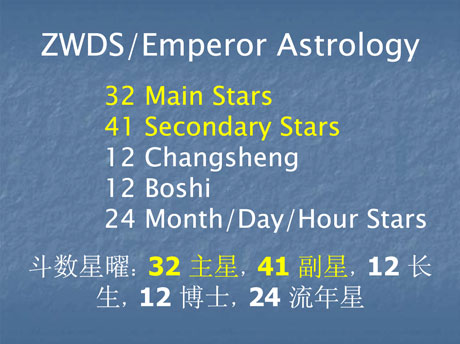
Commentary - First, the Mirroring Technique. It is used when a domain is found to be void of the 14 Major Stars (from the Emperor Ziwei to the Forward General Pojun). Regardless of how many other stars are present in a domain, when a domain is void of any of the 14 Major Stars, we have to use the stars present in the opposite domain. All the stars in the two groups of 73 stars (32 plus 41, in yellow fonts in the slide) found in the opposite domain must be mirrored into the domain to be interpreted. Merely mirroring the first 14 Major Stars, as it is widely taught, is wrong.
Slide 16
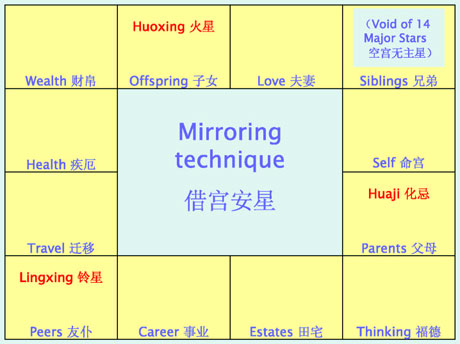
Commentary - The next three slides illustrate the Mirroring Technique. The Siblings Domain in the chart is void of Major Stars. The pair of Trouble Stars - Turmoil Star Huoxing and Turbulence Star Lingxing, are found to be placed in the Offspring Domain and Peers Domain respectively. They are not the 14 Major Stars, but part of the 32 Main Stars. They are the Adverse Stars that are the most menacing to human relationships.
Slide 17
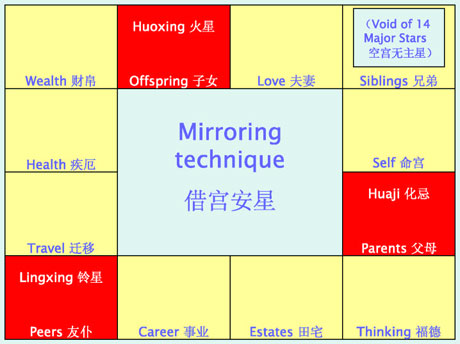
Commentary - In this chart, on the surface, three human relationship domains are negatively affected (in red) but not all five domains, if we do not mirror Turbulence Star Lingxing into the Siblings Domain which is void of the Major Stars. It therefore means that the Siblings Domain and Love Domain are not affect by the pair of Trouble Stars. This is the wrong interpretation result.
Slide 18
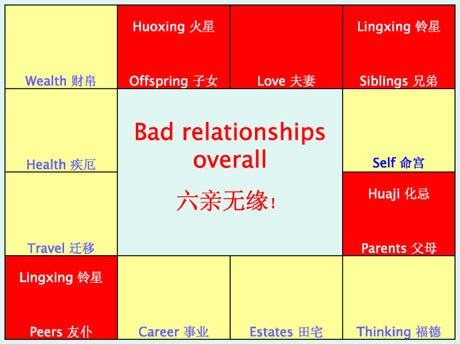
Commentary - When we mirror Turbulence Star into the Siblings Domain according to the correct application of the Mirroring Technique, we will have the correct interpretation result that all human relationship domains in this chart are ruined by the stars. The two that suffer the most impacts are the Parents Domain and Love Domain, the latter because of the flanking effect.
Slide 19
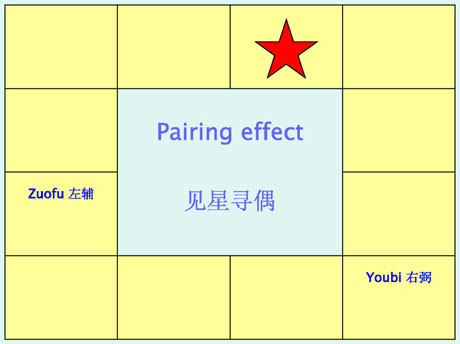
Commentary - Next, look out for the locations of stars that come in pairs. When a pair of stars are found in the Matrix, they give synergy. In this illustration, the Left Deputy Zuofu and the Right Deputy Youbi each affects the domains where they are placed, but the domain represent by the star symbol gets the most benefits.
Slide 20
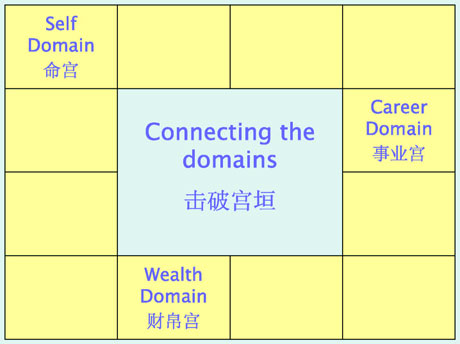
Commentary - This means that the interpretation of a ZWDS chart must not be done on individual domains only. In this illustration, Career Domain directly shows what industry or what sector is good for the subject, whether it is appropriate for him/her to take up a business or stay employed. However, his/her luck with money (Wealth Domain) also has a major influence on the job/business he takes on, while his/her personality (Self Domain) also plays a vital part in his/her rate of success in certain fields of job/business.
Slide 21/22/23


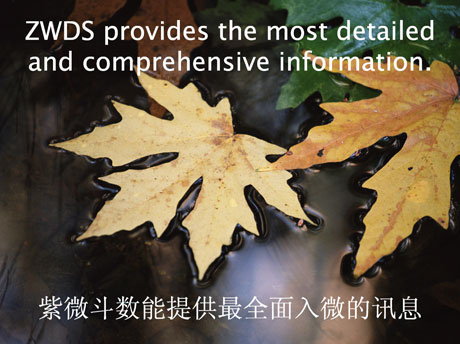
Commentary - With the availability of the enormous information ZWDS can provide, it is easy to fall into traps of such thought that we are unable to change our life or dictate our future - because so much have been written. Rather, the idea should be the other way round that we can make full use of the information to maximise our potential and to minimise risks and avoid pitfalls in life. The future is in our own hands. The next phase of slides illustrate this philosophy well.
Slide 24

Commentary - This is familiar to all of us, is it not? Their weightage of influence on our lives is the heaviest from the top down, while the amount of control we can exert over them is the biggest from the bottom up. To me, it is more critical to find out our likely trends first than to talk about Fengshui. For instance, when both the structural trends and the cycle luck of Estates Domain is good, it is easier for us to get a good house and good Fengshui. When they are the reverse, it is easier for us to get a bad settlement and bad Fengshui. Modern applications of ZWDS:
Slide 25/26
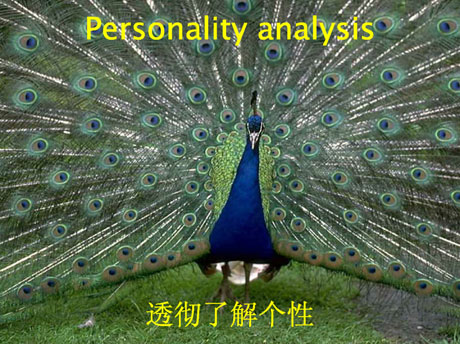

Commentary - Personality analysis. This is a chart of a young engineer. Passion Star Lianzhen and Pleasure Star Tanlang are about Peach Blossom luck and represent talent. When they are found to be in a combination like this, however, it indicates a free soul who prefers to wander than to get tied down, to express freely than to be meticulous, to be creative than to follow rules. Together with the pair of Interference Stars, Dikong and Dijie flanking the Self Domain, this quality is even more exaggerated. Do they fit the description of an engineer? The young man is already very frustrated with his daily work two years into the profession. This is a result of wrong guidance from the parents who wanted their children to have their (parents) choices of professions. What should he do now, especially in a society that is very restrictive? I have found out what his true talents are, and have encouraged him to indulge in those artistic talents over the weekends. This aims to balance his life.
Slide 27

Commentary - Personality analysis. This is the chart of the younger sister of the engineer, who is about to make a choice of study course. The mother wanted her to be a teacher, but she has wished to be in hospitality trades. In fact, the girl offered to pay me extra to dissuade her mother. I have told her there was no such necessity, as the combinations of her chart show that she would excel in tourism studies/work.
Slide 28/29

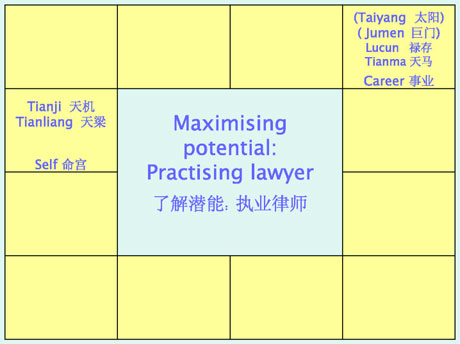
Commentary - Potential maximisation. When ZWDS is the most powerful in providing details about personality, it naturally helps to identify the best type of profession/business. Chief Advisor Tianji and Inspector Tianliang combines shows a clear and meticulous mind sharp in picking up details instantaneously. Combining with the stars found in the Career Domain, it is only appropriate that the subject is in the legal profession.
Slide 30

Commentary - Potential maximisation. This chart shows that the subject is born with the natural capacity of a business person. In fact, she was a homemaker because the husband was doing well, and she did not need to work. After the children have grown up, she started some business in a very small way but it grew naturally. In about ten years, she has four branches.
Slide 31/32


Commentary - Risk identification. With the power to go for details, ZWDS is certainly helpful for this function. Slide 32 shows a typical structure that the subject will be ultimately betrayed by the partner, while the initial period (a year, two years, etc.) does provide good returns.
Slide 33

Commentary - This is the same chart as in Slide 29. While the lawyer can excel in his profession well, he is to avoid investments, reading from his Wealth Domain.
Slide 34/35/36



Commentary - As ZWDS also provides details in periodic luck, it is an excellent instrument to help us in deciding the right timing. Slide 36 is the chart of young entrepreneur whose turnover met the qualification of the Young Entrepreneur Award if he were to submit his application. As he was sort of working for his family business, he wished to strike out totally on his own when he was 29. Going with the periodic luck, the Seal Minister Tianxiang indicates the luck of a number two instead of the luck of a leader. The advice was to put the idea off until his next decade. Meanwhile I have advised him to make use of the remaining years in the current period to learn all he can.
Slide 37

Commentary - This is from a chart that is structurally good, but the subject has made an investment in real estates during the period. Although that is the only one major mistake, it has also cause some great anxiety.
Slide 38

Commentary- Life Crisis Management. Likewise, prior information is the key here. We can work out the best solutions to a problem, and also find out the duration of a crisis.
Slide 39

Commentary- Compatibility Studies. Due to exactly its power to read personality and luck cycles, ZWDS is useful for studying the compatibility of business partners and marriage partners.
Slide 40

Commentary- Marital Counselling. ZWDS is an effective tool to carry out what I call alternative counselling, because it presents two people stripped nakedly in terms of personality. From there, their expectations in life and their expectations of a relationship can be described clearly. When they hear these from a third party, they are more willing to pay attention clearly. With the additional descriptions of what are the possible problems in the future, and in specific time frames, the prior information helps two people work better for the relationship. It is like they have found out what might be in store, and I have always encouraged them to take it as a task to overcome an issue or a bad patch in the future hand in hand. With the right intention and in the right frame of mind, we can alter course, or minimise the negative impact of a potential problem.
Slide 41

Commentary- HR Management. Enough is said by now about how to make use of ZWDS.
Slide 42/43


Commentary- Self explanatory.
Slide 44

Commentary- The 32 Main Stars have different degrees of brightness when they are placed in different positions. A bright star is able to show more of its strength while its weaknesses is minimised. A dim star manifests more of its weaknesses while its strength is reduced. There are altogether six or seven levels of brightness (left box), but I advocate simplifying them to a total of three (right box). There is no real requirement to go for such detailed grading, and we can afford to make learning ZWDS slightly easier.
Slide 45


Commentary- Self explanatory.
(Article kind courtesy of Master Tony Tan, Harmony Academy of Chinese Metaphysics)
http://www.absolutelyfengshui.com/library/brief-history-of-zi-wei-dou-shu-1.php

0 comments
Post a Comment